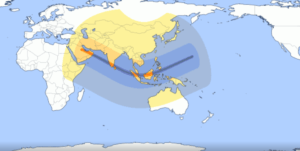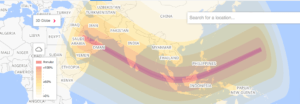December 26, 2019
An Annular solar eclipse will be visible from Saudi Arabia, Oman, southern India, and parts of Indonesia. In most of Asia, parts of North/East Africa, and North/West Australia, people can see a partial eclipse.
What is a Solar Eclipse?
A solar eclipse takes place when the Moon passes between Earth and the Sun, thereby totally or partly blocking the Sun for a viewer on Earth. A total solar eclipse occurs when the Moon’s apparent diameter is larger than the Sun’s, blocking all direct sunlight, turning the day into darkness.


When the Eclipse Happens Worldwide — Timeline
The eclipse starts at one location and ends at another. The times below are actual times (in UTC) when the eclipse occurs.
| Event | UTC Time | Time in Southern India* |
| First location to see the partial eclipse begin | 26 Dec, 02:29:53 | 26 Dec, 07:59:53 |
| First location to see the full eclipse begin | 26 Dec, 03:34:33 | 26 Dec, 09:04:33 |
| Maximum Eclipse | 26 Dec, 05:17:46 | 26 Dec, 10:47:46 |
| Last location to see the full eclipse end | 26 Dec, 07:00:55 | 26 Dec, 12:30:55 |
| Last location to see the partial eclipse end | 26 Dec, 08:05:40 | 26 Dec, 13:35:40 |
Where will it be visible?
The eclipse will begin in Saudi Arabia about 220 kilometers northeast of Riyadh at 03:43 UT1 and will end in Guam at 06:59.4 UT1. It will reach India near Kannur, Kerala at 03:56 UT1 (9.26 am, IST). The shadow will reach the southeast coast of India at 04:04 UT1 (9.34 am, IST). Traveling through northern Sri Lanka, it will head into the Bay of Bengal.

Precautions to be taken while observing Solar Eclipse!
Viewing the Sun with our naked eyes for more than a few seconds could damage our eyes. And henceforth, viewing the Sun during Solar Eclipse with naked eyes could even lead to permanent eye damage. We should take necessary precautions to ensure our safety and the safety of others.
You don’t always need a telescope to view the Sun, all you need is an appropriate filter, and a piece of No. 14 Arcwelder’s glass is a very popular choice. Welder’s filters of shades 12 through 14 are the safest solar filters.
We can also use a simple projection system and project the image formed at the eyepiece of a telescope on a white sheet and observe it safely or make a pin hole/ ball projector.

Solar view glasses are special eyewear, which can be used for direct viewing of the Sun. Standard sunglasses are not able to filter out eye damaging radiations coming from the Sun. These solar view glasses filter visible, ultraviolet, and infrared light. The eye’s retina does not have pain receptors, and thus damage could occur without one’s awareness.


An Eclipse Never Comes Alone!
A solar eclipse will always take place about two weeks before or after a lunar eclipse and vice-versa. Mostly, there occurs two eclipses in a row and at other times; there are three that can occur during the same eclipse season. A Penumbral Lunar Eclipse will follow this solar eclipse on January 10, 2020.
Stay tuned for more updates!
situs togel
toto togel
toto togel
toto slot
toto slot
toto togel
situs togel
data macau
prediksi hk
prediksi sdy
situs toto
toto slot
situs toto
situs toto
pam4d
situs togel
gimbal4d
pam4d
pam4d
gimbal4d
sangkarbet
sangkarbet
gimbal4d
situs toto
situs toto
toto slot
situs toto
toto slot
situs toto
situs toto
toto slot
situs toto
situs toto
toto slot
pafikotatambrauw.org
pafikotapegununganbintang.org
pafikotamimika.org
pafikotamamujutengah.org
pafikotamalukutenggara.org
pafikotabovendigoel.org
pafikotamalukutengah.org
pafikotalannyjaya.org
pafikotakepulauanyapen.org
pafikotaintanjaya.org
pafikotaburuselatan.org
pafikotabiaknumfor.org

